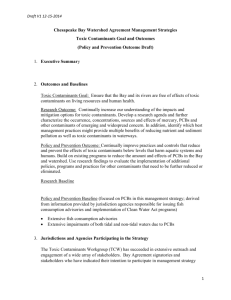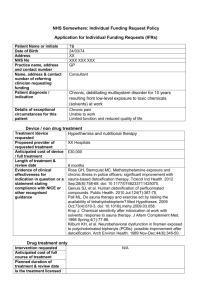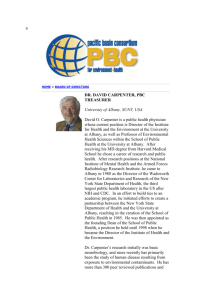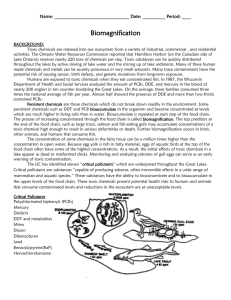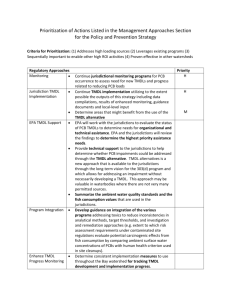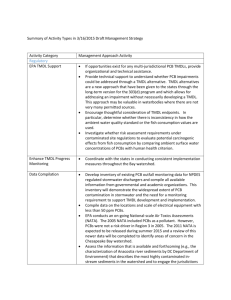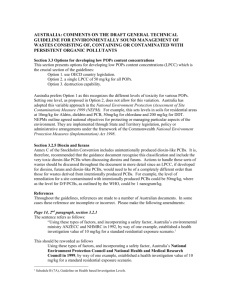IV. b. - Draft Policy and Prevention MS
advertisement
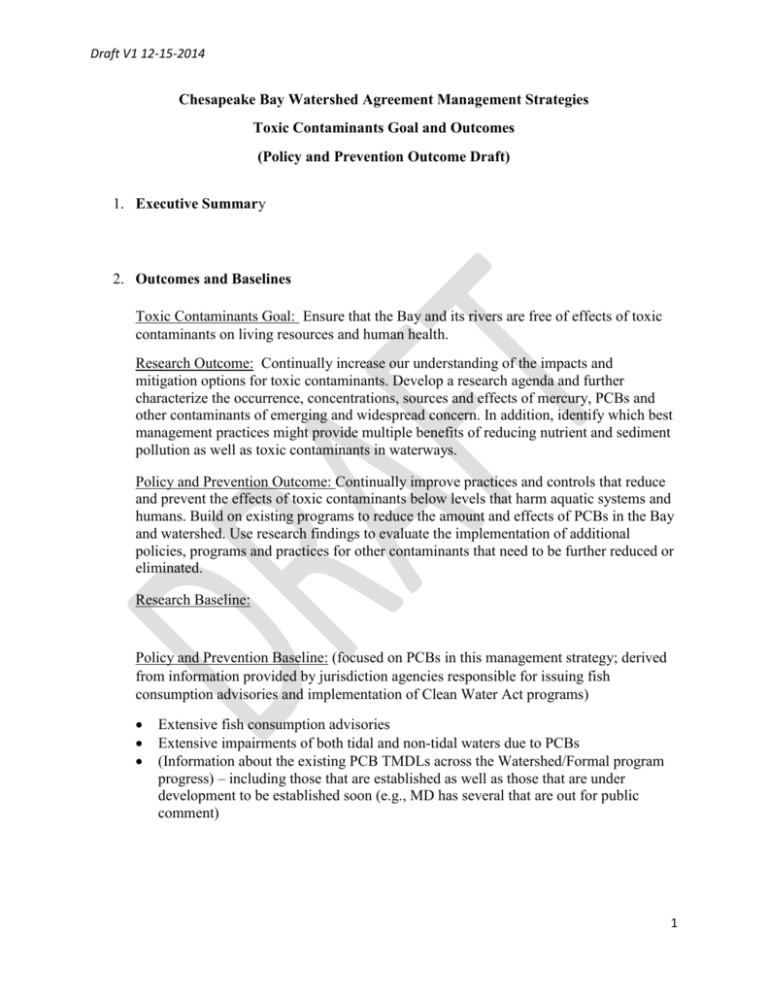
Draft V1 12-15-2014 Chesapeake Bay Watershed Agreement Management Strategies Toxic Contaminants Goal and Outcomes (Policy and Prevention Outcome Draft) 1. Executive Summary 2. Outcomes and Baselines Toxic Contaminants Goal: Ensure that the Bay and its rivers are free of effects of toxic contaminants on living resources and human health. Research Outcome: Continually increase our understanding of the impacts and mitigation options for toxic contaminants. Develop a research agenda and further characterize the occurrence, concentrations, sources and effects of mercury, PCBs and other contaminants of emerging and widespread concern. In addition, identify which best management practices might provide multiple benefits of reducing nutrient and sediment pollution as well as toxic contaminants in waterways. Policy and Prevention Outcome: Continually improve practices and controls that reduce and prevent the effects of toxic contaminants below levels that harm aquatic systems and humans. Build on existing programs to reduce the amount and effects of PCBs in the Bay and watershed. Use research findings to evaluate the implementation of additional policies, programs and practices for other contaminants that need to be further reduced or eliminated. Research Baseline: Policy and Prevention Baseline: (focused on PCBs in this management strategy; derived from information provided by jurisdiction agencies responsible for issuing fish consumption advisories and implementation of Clean Water Act programs) Extensive fish consumption advisories Extensive impairments of both tidal and non-tidal waters due to PCBs (Information about the existing PCB TMDLs across the Watershed/Formal program progress) – including those that are established as well as those that are under development to be established soon (e.g., MD has several that are out for public comment) 1 Draft V1 12-15-2014 3. Jurisdictions and Agencies Participating in the Strategy The Toxic Contaminants Workgroup (TCW) has succeeded in extensive outreach and engagement of a wide array of stakeholders. Bay Agreement signatories and stakeholders who have indicated their intention to participate in management strategy development have been identified on the workgroup membership list. The membership of the TCW includes members from the following groups: Maryland Department of the Environment Maryland Department of Natural Resources Virginia Department of Environmental Quality DC Department of the Environment Pennsylvania Department of Environmental Protection Delaware Department of Natural Resources and Environmental Control New York Department of Environmental Conservation West Virginia Department of Environmental Protection Federal Agencies: EPA, USGS, FWS, DHS, NOAA Non-Governmental Organizations Private sector organizations Local government organizations Academic institutions CBP Water Quality Goal Implementation Team Workgroups 3.a Local Engagement Whereas much of the focus on implementation of practices and controls to reduce the amounts and effects of PCBs will initially be targeted to federal and state regulatory programs, there will be many opportunities for local governments, watershed associations, nonprofits, and the private sector to engage in innovative and collaborative efforts. As described above, the TCW has engaged NGOs in the more urbanized areas of the Bay’s tidal waters. This was done to ensure that the organizations in those areas that are influential in local efforts to improve environmental condition (e.g., Blue Water Baltimore, Anacostia Watershed Society, Elizabeth River Project) are represented in the management strategy and also as one element of increasing the diversity of participating stakeholders because these organizations work actively in communities that tend to be socially diverse. In addition the TCW has several members that are from local water authorities (e.g., Washington Council of Governments, Hampton Roads Sanitation District) who are relied upon to help ensure that a local government perspective is considered and included to the extent appropriate in the management strategy. It is the responsibility of all members of the TCW to continually consider the level of engagement and implementation value of local entities in this management strategy. The strategy will be distributed on a regular basis for input from local entities. 4. Factors Influencing Ability to Meet Goal 2 Draft V1 12-15-2014 Policy and Prevention Outcome Factors Broad geographic extent and distribution of PCBs Political will to modify regulatory programs and/or create voluntary programs High cost of remedies: in-stream sediment remediation; WWTP modifications; electrical equipment replacements; stormwater controls; site remediation Shifting paradigms to acknowledge that there are ongoing sources of PCB loads 5. Current Efforts and Gaps (This text is retained to guide further development of this section)Identify efforts that are already being taken by jurisdictions, agencies and organizations Identify the gaps that the partnership should fill to meet the outcome. Identify possible interactions with other management strategies/outcomes and any possible efficiencies that might be achievable to avoid duplication, close gaps, and maximize forward efforts. Financial information, including needs and available resources should be identified and included where appropriate. To summarize current efforts, the Toxic Contaminants Workgroup has chosen to organize information by PCB loading mechanism. Within each mechanism, the sources of PCBs specific to that mechanism and current programs, gaps and potential are discussed Stormwater Overview - Stormwater is a major mechanism for the transport and loading of PCBs to the surface waters of the watershed. Stormwater transports both dissolved and particulate-attached PCBs. Stormwater in urbanized areas is more likely to be contaminated with PCBs than stormwater in suburban, agricultural, or forested land areas. Stormwater becomes contaminated with PCBs due to runoff from contaminated surfaces (soils, hardscapes). Those surfaces are contaminated due to industrial land uses, spills, and atmospheric deposition of PCBs. Stormwater Sources and Current Management Efforts to Control or Reduce Loads Contaminated Soils Spills Atmospheric Deposition (on the landscape) Wastewater Overview - Wastewater loading of PCBs occurs from both industrial and municipal wastewater discharges. In industrial discharges, wastewater is contaminated by process waters and through the inadvertent production of PCBs. Municipal wastewater becomes 3 Draft V1 12-15-2014 PCB contaminated due to the extremely varied sources of municipal influent, which often includes light industrial waste water and other Wastewater Sources and Current Management Efforts to Control or Reduce Loads Industrial Wastewater Municipal Wastewater Groundwater Overview – Groundwater can be a loading mechanism for PCBs particularly when it underlies highly contaminated surface soils. Contaminated groundwater that is near edge of stream are more likely to contribute to bio-availability of PCBs than upland groundwater. Groundwater Sources and Current Management Efforts to Control or Reduce Loads Contaminated Soils Atmospheric Overview – Atmospheric loads occur both as indirect loading to the land surface which is transported to surface waters mostly through stormwater and as loading that is directly deposited on surface water. Atmospheric Sources and Current Management Efforts to Control or Reduce Loads Industrial Releases In-Service PCBs (e.g., transformers) In-Stream Sediment Overview – In many areas of the watershed, PCB-contaminated sediments have accumulated on the bottom of streams, rivers, embayments and the Bay. The contamination comes from many sources and its presence is explained by the high affinity for PCBs to bind with sediment and be transported by surface waters. These sources and transport lead to the accumulation of contaminated sediments. In-stream Sediment Sources and Current Management Efforts to Control or Reduce Loads Defining the source of anthropogenic contamination into waterway sediments can be a difficult task. This is particularly true in settings where multiple point sources are present along with persistent non-point sources. This situation often results in complex mixtures of contaminants in sediments. Remediation of PCB-contaminated sediments may affect local and downstream water quality during activities such as dredging and dewatering. The Clean Water Act establishes requirements and discharge limits for actions that affect surface water quality. Accordingly, the 4 Draft V1 12-15-2014 technical requirements of permits, such as the National Pollutant Discharge Elimination System (NPDES) permit, may have to be met. CBP Member Management Efforts to Control or Reduce Loads An initial goal for this portion of the Toxic Contaminant management strategy is to assess the Total Maximum Daily Loads (TMDLs) implemented by CBP members to reduce nutrients and sediment which will also reduce toxic contaminants, and identify the relative amount of reduction that might occur across the range of best management practices (BMPs) to the extent such information exists. To meet this goal, a study will be conducted to identify in-stream toxic contaminants or contaminant groups (e.g., polychlorinated biphenyls, polycyclic aromatic hydrocarbons, and agricultural pesticides) affected by BMPs. The BMPs will be cross-correlated with contaminant loading mechanisms and their association with land use and industrial sources (e.g., urban stormwater, agriculture, landfills, dredged material disposal facilities, hazardous waste sites, and industrial operations). The study will assess and explanation of the most beneficial management actions that could leverage current TMDLs and watershed implementation plans (WIPs) to achieve multiple benefits for nutrient, sediment, and toxic contaminant reductions. And, the study will identify conditions that might be relevant and necessary (e.g., siting, construction, and operation) for BMPs to result in toxic contaminant reductions. Combined Sewer Overflows Other loading mechanisms? 5.a Actions, tools or technical support needed to empower local government and others. There is a need for communications tools that will emphasize the connection between PCBs and human health especially with regard to risks from the consumption of contaminated fish. It is expected that such information will motivate local and state-level governments to continue to apply public resources to mitigate and reduce PCBs with the additional benefit of raising awareness of safe levels of fish consumption for anglers in the watershed. 6. Management Approach The TCW’s objective is to develop a management approach that adds value to the ongoing work of jurisdiction, federal, and local entities with respect to PCB controls and reductions. In keeping with the Chesapeake Bay Program Partnership’s (the Partnership) mission, the TCW will look for opportunities to accelerate, enable and continually 5 Draft V1 12-15-2014 improve the management actions described above, finding synergies and opportunities to share information across the partnership about what approaches are most cost effective (including based on information from other watershed programs). The management approach described below identifies near term actions that are directly focused on management actions to reduce PCBs as well as the continuation of data synthesis and analysis to enhance future decisions on how the Partnership can enhance existing efforts. A key objective in the management approach is to seek out innovation and develop new commitments and stakeholder partnerships that will work to reduce PCBs within regulatory programs and across voluntary programs. The approach will follow analysis of the relative size of the PCB load across the different loading mechanisms and sources followed by assessment of where there are opportunities to enhance existing programs for those sources and to create new programs. The management approach will be highly influenced by what we learn from other watersheds (e.g., Delaware Bay and the Great Lakes) as far as identifying management actions with the lowest cost to highest benefit. 6.a Local Engagement In the more urbanized areas of the Bay, Baltimore, Washington D.C. and Norfolk/Elizabeth River, the TCW will continually coordinate and engage with NGOs and state and local governments as the management strategy is developed and implemented. 7. Monitoring Progress. Three types of progress monitoring will be pursued: 1) Progress on completion of planned activities for actions not directly under the direction of the Partnership and progress for activities for which the TCW is directly committing to oversight and dedication of resources of the Partnership 2) Assessment of whether planned actions are having the result expected 3) Environmental monitoring to track response of the system as the strategy is implemented (to the extent possible given the high cost of PCB monitoring and the lag time that will influence how quickly an environmental response is detectable) 8. Assessing Progress For type 1) progress monitoring as described above, the frequency of assessing progress will be at least annual so that adjustments to the biennial workplan can be made to accommodate changing circumstances and availability of resources. Formal review of type 1) progress data will be completed through the update of the biennial workplan. 6 Draft V1 12-15-2014 Progress assessment based on type 2) and 3) monitoring will be conducted on an asavailable basis. These types of monitoring generally will involve measurements of environmental response and environmental condition, which do not necessarily occur at regular intervals and will be contingent on availability of data and/or monitoring funds. 9. Adaptively Manage Adaptive management will focus foremost on monitoring information described under type 2) above where there will be assessment of whether management actions are having the expected results in terms of PCB reductions. Over time, it is expected we will learn which loading mechanisms and sources provide the greatest opportunities for continued reductions. Other adaptations to the strategy will result from assessing the long term response of the system (type 3 monitoring above) and, in the short term, whether the TCW and other entities are completing work as planned (type 1 monitoring above). 10. Biennial Workplan summarize the commitments, actions and resources that each jurisdiction, federal agency and partner will take to help achieve each of the outcomes Biennial workplan to be developed 7
